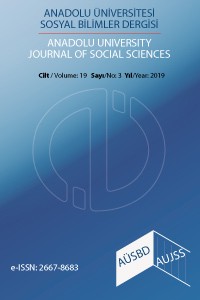Öz
Bu araştırmanın amacı, kuşakların sağlık hizmetlerinde tüketici sağlığı bilişimi teknolojilerine yönelik kullanım düzeylerini tespit etmektir. Bu kapsamda Isparta’da yaşayan 431 bireyden toplanan veriler değerlendirilmiştir. Yapılan analizler; tüketici sağlığı bilişimi kullanımının kuşaklar arası değişkenlik gösterdiğini ve kullanım düzeylerinin Y>X>Z şeklinde sıralandığı sonucunu ortaya koymaktadır.
Anahtar Kelimeler
Sağlık Hizmetleri Sağlık Teknolojisi Kuşak Tüketici Sağlığı Bilişimi Sağlık Yönetimi
Kaynakça
- Anderson, K.M., Marsh, C.A., Flemming, A.C., Isenstein, H. ve Reynolds, J. (2012). Quality Measurement Enabled by Health IT: Overview, Possibilities, and Challenges, United States, Agency for Health Research and Quality Advancing Excellence in Health Care Publication No. 12-0061-EF.
- Andreassen, H.K., Bujnowska-Fedak, M.M., Chronaki, C.E., Dumitru, R.C., Pudule, I., Santana, S., Voss, H. ve Wynn, R. (2007). European Citizens Use of E-health Services: A Study of Seven Countries, BMC Public Health, 7(53),1-7.
- Biztatar, H. (2017). Olumsuz Elektronik Ağızdan Ağıza Pazarlama İletişimine Etki Eden Faktörler: Z Kuşağı Tüketicilerinin Görüşlerini Belirlemeye Yönelik Bir Araştırma. (Yüksek Lisans Tezi), Çağ Üniversitesi Sosyal Bilimler Enstitüsü, Mersin.
- Bower, M., Sturman, D. (2015). What are the Educational Affordances of Wearable Technologies?, Computer and Education, 88, 343-353.
- Büyükkeçeci, E. (2017). Generation Z in Beginning Design Studio: A Case Study in Art and Design Studio at Izmir University of Economics. (Yüksek Lisans Tezi), İzmir Ekonomi Üniversitesi Sosyal Bilimler Enstitüsü, İzmir.
- Büyükuslu, F. (2017). Z Kuşağının İş Yaşamından Beklentileri Konusunda Bir Araştırma. (Yüksek Lisans Tezi), Bahçeşehir Üniversitesi Sosyal Bilimler Enstitüsü, İstanbul.
- Cheong, H.J., Shin, N.Y. ve Joeng, Y.B. (2009). Improving Korean Service Delivery System in Health Care: Focusing on National E-health System, International Conference on eHealth, Telemedicine, and Social Medicine.
- Chou, W.Y.S., Hunt, Y.M., Beckjord, E.B., Moser, R.P. ve Hesse, B.W. (2009). Social Media Use in the United States: Implications for Health Communication, Journal of Medical Internet Research, 11(4), 1-12.
- Dişçi, R. (2008). Temel ve Klinik Biyoistatistik (1. Baskı). İstanbul: İstanbul Tıp Kitabevi.
- Eysenbach, G. (2000). Recent Advances Consumer Health Informatics. British Medical Journal, 320(7251), 1713-1716.
- Ferguson, T. (1993). Doctom's FAQ: What is Consumer Health Informatics?. Erişim Tarihi 11 Nisan 2019, https://www.fergusonreport.com/articles/tfr07-03.htm
- Gibbons, M.C., Wilson, R.F., Samal, L., Lehmann, C.U., Dickersin, K., Lehmann, H.P., Aboumatar, H., Finkelstein, J., Shelton, E., Sharma, R. ve Bass, E.B. (2011). Consumer Health Informatics: Results of a Systematic Evidence Review and Evidence Based Recommendations. Translation Behavioral Medicine, 1(1), 72-82.
- Hesse, B.W., Nelson, D.E. ve Kreps, G.L. (2005). Rust and Sources of Health Information the Impact of the Internet and Its Implications for Health Care Providers: Findings From the First Health Information National Trends Survey, Jama Internal Medicine, 165(22), 2618-2624.
- Jimison, H.B., Sher, P.P. (1995). Consumer Health Informatics: Health Information Technology for Consumers, Journal of the American Society for Information Science, 46(10), 783-790.
- Keleş, A. (2007). Öğrenme- Öğretme Sürecinde Yapay Zekâ ve Web Tabanlı Zeki Öğretim Sistemi Tasarımı ve “Matematik Öğretiminde Bir Uygulama (Doktora Tezi), Atatürk Üniversitesi Fen Bilimleri Enstitüsü, Erzurum.
- Kreps, G.L. ve Neuhauser, L. (2010). New Directions in Ehealth Communication: Opportunities and Challenges, Patient Education and Counseling, 78, 329-336.
- Lerman, K. (2014). Healthcare Without Borders: How Millennials are Reshaping Health and Wellness. Boston.
- Morgan, G.A., Leech, N.L., Gloeckner, G.W. ve Barrett, K.C. (2011). IBM SPSS for Introductory Statistics Use and Interpretation (40. Edition) New York: Taylor and Francis Group LLC.
- Norman, C.D. ve Skinner, H.A. (2006) e-Health Literacy: Essential Skills for Consumer Health in a Networked World, Journal of Medical Internet Research, 8(2), 1-9.
- Pagliari, C., Sloan, D. ve MacGillivray, S. (2005). What is e-health (4): A Scaping Exercise to Map the Field, Journal of Medical Internet Research, 7(1), e9.
- Sağlık Bakanlığı (2014a). EHR (Electronic Health Record) - ESK (Elektronik Sağlık Kaydı). Erişim Tarihi 05 Ocak 2019, https://dijitalhastane.saglik.gov.tr/TR,4874/ehr-electronic-health-record---esk-elektronik-saglik-kaydi.html
- Sağlık Bakanlığı (2016). Merkezi Hekim Randevu Sistemi. Erişim Tarihi 10 Ocak 2019, https://www.mhrs.gov.tr/Vatandas/hakkimizda.xhtml
- Sundar, S.S. ve Marathe, S.S. (2010). Personalization versus Customization: The Importance of Agency, Privacy, and Power Usage, Human Communication Research, 36(3), 298-322.
- Toygar, Ş.A. (2018). e-Sağlık Uygulamaları. Yasama Dergisi, 37, 101-123.
- Venkatesh, V., Morris, M. G., Davis, G.B. and Davis, F.D., (2003). User Acceptance of Information Technology: Toward a Unified View, MIS Quarterly, 27(3), 425-478.
- Wilson, E.V., Lankton, N.K. (2004). Modeling Patients Acceptance of Provider Delivered E-Health, Jamia a Scholary Journal of Informatics in Health and Biomedicine, 11(4), 241-248.
- World Health Organization (2009). Report of Information and Communication Technologies for Women’s and Children’s Health: a Planning Workbook, Geneva/Switzerland: World Health Organization.
- World Health Organization (2011). Mhealth New Horizons for Health Through Mobile Technologies Global Observatory For Ehealth Series - Volume 3, Geneva/Switzerland, World Health Organization Global Observatory for eHealth.
- World Health Organization (2016a). Global Diffusion of Ehealth: Making Universal Health Coverage Achievable Report of the Third Global Survey on Ehealth, Geneva/Switzerland: World Health Organization.
- World Health Organization (2019). What is a Health Technology?. Erişim Tarihi 11 Haziran 2019, https://www.who.int/health-technology assessment/about/healthtechnology/en/
- Yazıcıoğlu, N. (2010). Yapay Zekâ ile Talep Tahmini. (Yüksek Lisans Tezi), Uludağ Üniversitesi Fen Bilimler Enstitüsü, Bursa.
- Zach, S. (1996). Telemedicine Overview and Summary, Nineteenth Convention of the Institute of Electrical and Electronics Engineers (IEEE), Jerusalem, Israel, 409-412.
- Ziuzianski, P., Furmankiwicz, M. and Soltysik-Piorunkiewicz, A. (2014). E-Health Artificial Intelligence System İmplementation: Case Study of Knowledge Management Dashboard of Epidemiological Data in Poland, International Journal of Biology and Biomedical Engineering, 8, 164-171.
Ayrıntılar
| Birincil Dil | Türkçe |
|---|---|
| Bölüm | Makaleler |
| Yazarlar | |
| Yayımlanma Tarihi | 30 Eylül 2019 |
| Gönderilme Tarihi | 16 Ağustos 2019 |
| Yayımlandığı Sayı | Yıl 2019 Cilt: 19 Sayı: 3 |
Bu eser Creative Commons Atıf-GayriTicari 4.0 Uluslararası Lisansı ile lisanslanmıştır.


